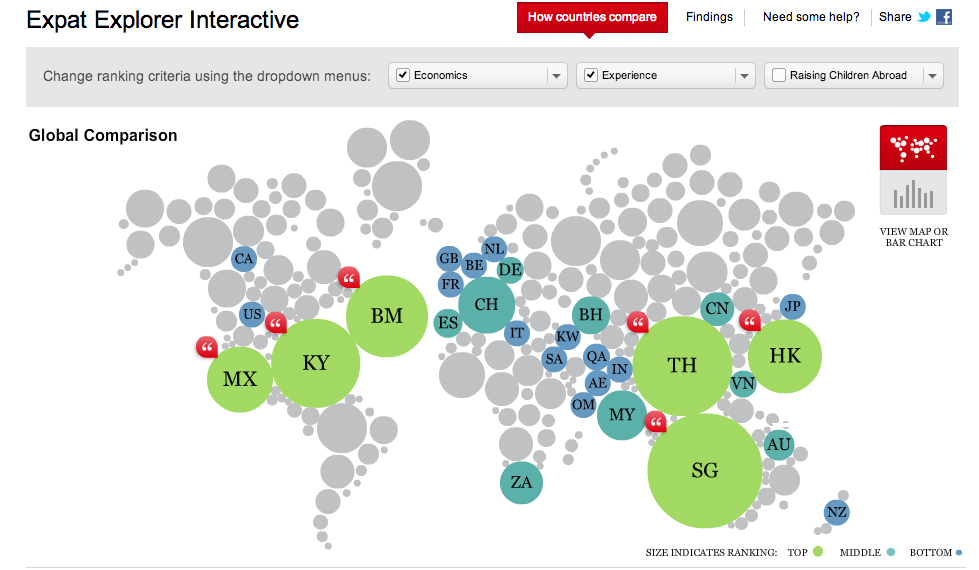
You might think that corporate institutions like banks and blogging don’t naturally go hand in hand. Think again. We’re delighted to present this month’s Valuable Content Award to the team at HSBC Expat.
When it comes to marketing with valuable content HSBC Expat gets it absolutely right. Have a look at the plethora of resources they provide – guides, surveys, videos, hints, tips, a superb blog, interactive tools, social updates – all carefully designed and widely shared. As you’ll learn from Digital Marketing and Social Media Manager Richard Fray, they have created a thriving hub of content that reaches out to the expat community and is winning them friends.
Whether you are a large corporate institution or a small business, there is MASSES you can learn about content marketing from Richard’s answers below. We’ve posted our award interview with him in full so make a cup of tea and take notes.
Huge congratulations to the HSBC Expat team. Your content is inspirational.
Q. Please tell us about your approach to content.
A. “HSBC Expat provides financial services for people living and working abroad. Moving abroad is a major life step. People seek out information from trusted sources to help them make the important decisions. We also know that for many people moving abroad, while sorting out their finances is important they are often more focused on other priorities – finding accommodation, a job, schools.
For the last few years now the HSBC Expat team has been developing useful information for expats to help them choose a country and research all aspects of their move. The business goal for our content is really to create a wider awareness of our offering and to build engagement with expats and those planning to move abroad as early as possible.”
Our approach to building content:
- Insight – we use research and data to work out what our audience needs.
- Design – the format for the content – we consider where it will live, how it can be interacted with, how it will be shared.
- Source the content – we tap into the expertise of our employees, customers, and trusted partners.
- Promote selectively – we use the channels we believe will be most effective for each type of content.
- Recycle – we encourage other teams and business areas to link to and re-use elements of the content in all their communications.
“We also think about how the content will integrate together and how we will make people aware of it across the digital ecosystem. The various online channels – paid search, email, content, social and so on are interdependent: paid can boost social, content reduce the cost of paid, email solicit new content and so on.”
Q: What type of content do you share?
“If you moved abroad, what would you want to know? This is the question that guides the content that we create and share at HSBC Expat.”
A: “Our content broadly falls into two categories: finance-related content created by ourselves and trusted partners, and lifestyle-related content created largely by expats themselves.
We have a dedicated Twitter channel (@expatexplorer) where we share useful information for expats – including content from sources other than HSBC, and a blog (expatexplorer.blogspot.co.uk) about expat lifestyle-related topics such as overcoming cultural challenges, expat relationships and so on. We often invite guest bloggers to create posts for our blog.
Our website (www.expat.hsbc.com) has expat finance guides as well as interactive tools to compare countries and browse tips from expats.”
Q: What results has this brought for your business?
A: “It has been very successful. To give an example, a couple of months ago we launched an Expat Hints and Tips tool www.expatexplorer.hsbc.com/hintsandtips, which is designed to help people plan a move abroad and to make the most of their time in a new country. It’s full of tips on expat life, crowdsourced from expats, and was promoted via social media.
The site has been used by people from almost every country in the world, with users from 174 countries to date. Following the launch, our @expatexplorer Twitter channel has become the second most followed HSBC Twitter channel worldwide.
At least as important as this raising of awareness of our offering has been the hundreds of positive comments we have had via social media. Some of my favourite examples include: “A cool way to share and learn from other expats”, “Oooh this is a nice idea, expats sharing stories and tips”, and “I love the Hints and Tips site, different and interesting and useful.”
From a content generation perspective, the site has over 1000 tips, submitted by expats and covering 66 countries, and we have been able to re-use these tips in other materials, most recently in a partnership with the Guardian.
Finally, we have seen positive results directly attributable to this content in terms of increased website visits from social media and natural search, and we have seen a healthy proportion of people using the tool then move on to view product information and generate leads, especially on subsequent visits to the website.”
Q: Example of some content that has worked really well?
A: “For the last four years we have run the Expat Explorer Survey. It’s the world’s largest survey of expats with more than 5,000 expats answering questions relating to their finances, quality of life, and even what it’s like to raise children abroad. The survey was the initial reason that we set up our Twitter and blog feeds, to share interesting insights from the results.
After running the survey for a year or so we thought, there is some really good data in here, how can we make more of this data and open it up so that it is not just useful for journalists, but for our customers and employees as well? How can we allow people thinking of moving abroad to ask their own questions of the data based on the things that are important to them?
There’s a quote I remember seeing in Advertising Age at the time, from Garrick Schmitt at Razorfish: “What data do you have that is truly valuable? And how can you create a meaningful experience or narrative out of it?’”. We created a beautiful, interactive data visualization based on the survey data , which allows users to see how expats rank countries based on a choice of 55 criteria, and compare countries side by side based on the criteria important to them.”
“Again, the engagement from expats was fantastic, with comments such as: “Kind of cool for the ‘world’s local bank’ to launch this.” And “The HSBC interactive expat explorer tool is lovely.” The Telegraph said it was: “A testament to the growing importance of social media to the expat community.”
The tool reached over 200,000 users with no advertising spend, purely promoted via social media and press releases. Launched two years ago, the tool still has a steady stream of users and of shares on social media, showing the longevity of really good content.”
Q: How do you manage the content creation challenge?
“Never underestimate the content creation challenge.”
A: “Content creation is shared between the various teams and agencies looking after owned, paid and earned media. We have found that we get the best results when we use all three kinds of media together.
Never underestimate the effort required to create high quality content on a continued basis. The entertainment and news media have been doing this for a long time and have developed the processes, skills and resources to do it. For brands, whose experience and expertise generally lies more in product development and customer service, it can be more of a learning curve.
That said, it is those skills – the rigour and planning of product development, and the customer-first mindset of good customer service, that brands can draw on for their content programmes.”
Some of the things that have helped us are:
- Prioritisation: using customer insight and previous successes to understand what we should focus on – one piece of relevant, targeted, popular content is worth a hundred pieces of irrelevant content.
- Frugality: re-using content in as many different channels and assets as possible.
- Insourcing: reaching out to our customers and employees to help create content for us.
- Outsourcing: where necessary working with specialist partners such as the media to co-create content.
- Having a plan: there’s nothing like a regular deadline to make sure that something gets done!
Q: Other content challenges?
A: “Measurement and attribution of results to content marketing can be a challenge. Information and lifestyle content doesn’t convert as immediately as, say, a product landing page or direct email but we are more likely to see people coming back again at a later date and reading more about our products. So we need to try to attribute this activity back to the content that originally piqued their interest. It’s also important, if more complicated, to attribute a value to the awareness and engagement outcomes of our content, as these are clearly very important too.
Having too much content can also be a problem! We need to remain on top of how our content is organised, how it can be found by users and to keep testing the site navigation with users to ensure they can get to the content they want. The topic of moving to another country is so broad that we also need to be really focused on what is realistic for us to create and update, what is a good fit with our brand, and what will be genuinely useful for expats, that they hopefully can’t find anywhere else.”
What’s next for your content?
“It’s not always about creating new content. Making the most of the content we already have is just as important, maybe even more so.”
“For us, this year is about taking stock of the best of the content that we have created over the last few years and how we take that content and repackage it in new ways and places to increase the value from it and the value to our customers. This includes looking at how we can enhance the way users can consume this content on mobile devices, and also potentially making it available in new forms, ‘offline’ in the physical world.
That said, we have a few nice ideas for new content too, so watch this space!”
Any valuable content tips for other businesses?
1. Get the basics in place first
“Treat content development like product development. Think about these questions before you even start creating content:
- How does the content meet a customer need?
- How can you create it cost-effectively?
- Where will it be stored?
- How will it be distributed and consumed?
- How will you promote it?
- Will you charge for it?
- What is the roadmap for updating or enhancing it?
- And how will you know it has been successful?”
2. Create content that’s right for your audience, but also for your brand
“There is not a shortage of content in the world. Google’s Eric Schmidt famously said that every two days, we now create as much information as we did throughout the entire history of mankind up to 2003. When you create content you are competing for your audience’s attention. And you are not just competing with other companies but with the news and entertainment media, and with peoples’ friends and family on social networks. Therefore, to get your audience’s attention, you are going to need some very good, very relevant content.
What’s good content? Good content is ultimately content that has utility for the person consuming it. That utility could be entertainment, it could be news, it could be education, it could save the person time, it could help them solve a problem.
I think you also need to have authority on the topic you are talking about. You have to have – or to earn – the right to be able talk about that topic credibly, otherwise your audience will just listen to someone else who can.”
3. Be generous
“Brands can often marshal the resources – budgets, technologies and people – to do things that individuals acting alone cannot. You can harness these resources on behalf of your customers in order to create something genuinely useful for them. You have to trust that if you get this right, then your business needs will also be met. Certainly, that has been our experience at HSBC Expat.”
Great advice. Congratulations Richard and the HSBC Expat team. A well-deserved Valuable Content Award is on its way to you.
We hope this helps to reward you for all that hard work.
Learn from previous Valuable Content Award Winners:
- Indium Corporation: from one engineer to another
- Ascentor: squeezing juicy content from a dry industry
- Novatech’s very social social media approach
- Sands Beach Resort’s relevant content inspires the right people







Trackbacks/Pingbacks